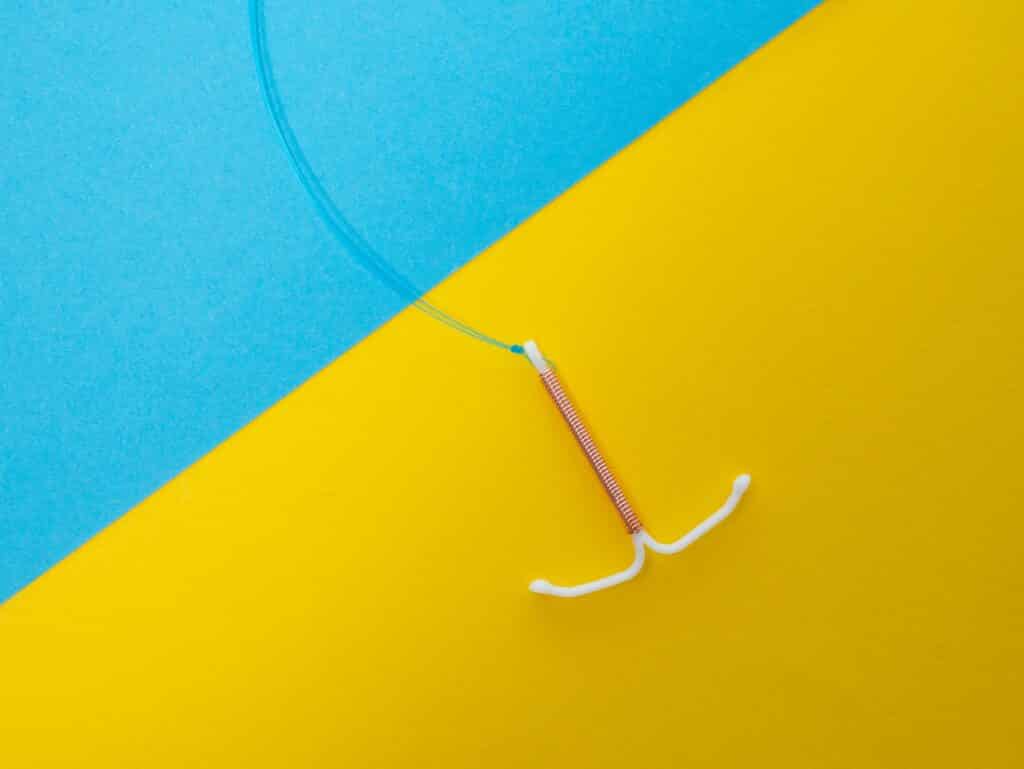Have you ever asked yourself the question: “Should I get an IUD?” And if yes, “Where can I get an IUD?” Women who are exploring the option of getting an intrauterine device understandably have many questions and concerns about what it entails exactly. In fact, a growing number of women have decided to ditch birth control pills and other forms of contraception and are embracing IUDs due to their effectiveness and safety.
As someone who has an IUD, I know the prospect of getting one can be scary, and many women are both underinformed or misinformed about them. But I’ve scoured the web and shared my experience so that you are empowered with everything you need to know. Here we cover everything you should know about IUDs, as well as what you should know before getting one.
IUDs Explained
IUD stands for intrauterine device, is shaped like a “T” and is just a bit bigger than a quarter. It fits inside your uterus and works to prevent pregnancy by blocking sperm from fertilizing your eggs.
IUDs are considered highly effective forms of contraception, and when used correctly, your chance of getting pregnant is less than 1%. Other benefits of IUDs include:
- Long-lasting: Depending on which brand you get; they can last anywhere from 3 to 10 years.
- Hassle-free: Once an IUD has been inserted, you don’t have to think about it (and neither does your partner).
- Once-off cost: Unlike other contraceptives, an IUD is one cost upfront.
- Breastfeeding friendly: IUDs are safe to use while breastfeeding.
- No reminders: Unlike other contraceptive methods like the pill or injection, IUDs require no usage reminders.
- Doesn’t influence weight: Similarly, IUDs do not affect weight and won’t cause any weight loss or gain.
Getting an IUD: The Types Explained
IUDs fall into two primary categories:
- Hormonal IUDs
- Non-hormonal IUDs
So, what is the difference between hormonal IUDs and non-hormonal IUDs?
As mentioned earlier, all IUDs stop sperm from fertilizing your eggs. Non-hormonal IUDs are made of copper and act as a natural spermicide.
On the other hand, hormonal IUDs release progestin – a synthetic form of the sex hormone progesterone – which thickens the cervical mucus and makes it difficult for sperm to pass through the uterus. In addition, they prevent eggs from leaving the ovaries to get fertilized.
At the moment, the only non-hormonal IUD on the market is ParaGard and lasts for up to a decade. The main side effect of ParaGard is the possibility of abnormally heavy periods, but it tends to decrease over time – usually after the first year.
There are more options available when it comes to hormonal IUDs, Mirena (the one I currently have), Liletta, Skyla, and Kyleena. These differ in terms of cost, how long they last, and how much progestin they release. Generally, these kinds of IUDs lighten period flow and lessen cramps. Some women stop menstruating altogether, which is more likely to happen with IUDs that contain higher progestin like Liletta and Mirena.
As for how long each IUD brand tends to last, here are some averages:
- Skyla: 3 Years
- Kyleena: 5 Years
- Mirena and Liletta: 6 Years
- ParaGard: 10 Years

Potential Side Effects of IUDs
Deciding on which IUD is best for you depends on which side effects you’ll be able to handle best.
IUDs are safe but some women do experience mild side effects and serious complications are rare.
Some women feel lightheaded after their IUD insertion, but the feeling typically passes after a few minutes. It is also normal to expect period-like cramps and light spotting after the first few days of your insertion. This was the case for my experience after my IUD was inserted. A hot water bottle and some painkillers will do the trick.
You are very unlikely to fall pregnant while you have an IUD. But if you do, having an IUD raises your risks for miscarriage, infection, and early labor and delivery. If you suspect you might be pregnant, let your doctor know immediately.
While IUDs have a good safety record, post-insertion pain is worth noting. But if you experience persistent abdominal cramping, pain during sex, or bleeding after sex you should head back to your doctor.
Whenever a foreign object goes into your body, there is a chance it could work its way out. Expulsion with IUDs is most likely to occur within one year of insertion. If it shifts out of place, it may become ineffective against pregnancy.
There is also a low possibility that the IUD will poke through the wall of the uterus and end up in the belly cavity. In this instance, surgical removal would be necessary. This is the most serious of all possible complications with IUDs.
About 1 in 10 women will get ovarian cysts in the first year after they get an IUD. They’re usually harmless and go away on their own within 3 months. But some can cause bloating, swelling, or pain in the lower belly. If a cyst ruptures, it will cause severe pain. See your doctor if you have these symptoms.
Common IUD FAQs
Can Anyone Get An IUD?
Most healthy women can get an IUD. They are especially suited to women with one sexual partner and at low risk of contracting an STD since IUDs don’t protect against STDs.
You should not get an IUD if:
- You have an STD or recently had a pelvic infection.
- You are pregnant.
- You have cervical, breast, or uterus cancer – or if you are at high risk of breast cancer.
- You have unexplained vaginal bleeding.
- You have liver disease.
You are not a good candidate for the copper IUD if you have a copper allergy or have Wilson’s disease, which causes your body to hold too much copper. In rare cases, the size and shape of your uterus will make it tough to insert an IUD.
When Can You Get An IUD?
You can get an IUD any time you want, as long as you aren’t currently pregnant. There’s no minimum age for IUD insertion. And they’re effective and safe whether or not you’ve been pregnant before. Non-hormonal IUDs double as emergency contraception if inserted within 5 days of unprotected sex.
Some women opt to get IUDs right after they’ve given birth. Since they’re right there and the doctor has easy access to their uterus – plus IUDs don’t interfere with breastfeeding. The only potential downside of postpartum IUD insertion (10 minutes to four weeks after delivery) is an increased chance of expulsion. This is only 15 – 20% compared to 5% for IUDs inserted at other times.
IUD expulsion is when it moves out of its correct position in the uterus or leaves the uterus entirely. If you can feel the device itself, instead of just the strings, this is a sign of expulsion. Severe pain or bleeding is also an indication that the device has shifted.
How Is An IUD Inserted?
Your doctor will usually insert the IUD during an office visit and may suggest you take over-the-counter medication, like ibuprofen a few hours before your procedure to lessen cramping. You can request a day clinic visit if you would prefer to be under anesthetic during insertion. Otherwise, they usually insert the IUD during your period or just after it ends when your cervix is most open.
Similar to getting a pap smear, your feet will be placed in stirrups, and the doctor will place a speculum in the vagina to hold it open. Then your doctor will place the IUD in a small tube which will then be inserted into your vagina. Your doctor will move the tube up through the cervix, into the uterus, and push the IUD out of the tube, and pull the tube out. Strings attached to the IUD will hand 1-2 inches into the vagina.
Expect the procedure to be uncomfortable, and it’s normal to experience cramping and bleeding, but they tend to go away in a few days.
How Soon Do IUDs Start Working?
Non-hormonal IUDs, like ParaGuard, are effective as soon as insertion is complete.
If you have a hormonal IUD inserted during your period, it will start working immediately. Otherwise, this kind of IUD may take up to 7 days to be effective.
Does It hurt?
This depends. Typically, IUD insertion is less painful for women who’ve given birth vaginally within the past two years. In one study conducted on IUD insertion pain, 4 in 5 women reported between no discomfort and only moderate pain, and more than 70% of the participants had never been pregnant.
In another study, around 77% of women said they were satisfied with their insertion procedure, and 83% said the benefits of the IUD were worth any discomfort they felt.
Some women report pain for up to a week after insertion. If you are very worried about pain, talk to your doctor about the option of an anesthetic.
What Do You Need To Do After Insertion?
Basically nothing. It’s a set-it-and-forget-it birth control method – which is part of the reason why IUDs are so effective. Since an IUD lasts anywhere between three and 10 years, depending on which kind you get, you can remove it after however long you wish.
While the device is in you, you can get it checked during your visits to the OB-GYN to make sure it hasn’t shifted. But you can also do a self-check. If you can’t feel the strings though, don’t worry – as long as you don’t experience abnormal pain, bleeding, or unusual discharge.
In one study done on women’s ability and willingness to check for their IUD strings, about half of participants either didn’t check for the strings or couldn’t feel them, and their IUDs were just fine.
What Else Do You Need To Know About The Strings?
The strings are attached to IUDs to make removal easier – almost like a tampon. A few different complications might prevent your doctor from removing the device with a gentle tug. For instance, the strings might not be visible due to expulsion. Or they might be broken, which generally happens to IUDs inserted after childbirth.
If the strings aren’t visible, your doctor will likely perform an ultrasound to locate and remove the IUD.
Usually, doctors cut IUD strings to around 2-3 centimeters long, but you can talk to your doctor about keeping them longer or shorter. If you are worried about your partner being bothered by the strings, don’t stress. This isn’t usually the case. One study discovered that 14% of male partners were bothered by the strings. But you can also go back to the doctor and ask them to trim the strings after insertion.
Where Can You Get An IUD?
Now, you may be wondering, “Where can I get an IUD?”. Well, they’re easy to get your hands on. You can request any healthcare professional, or GP about IUD contraception. And most Planned Parenthood clinics, as well as any OB-GYN.
Knowing the benefits, procedures, and potential risks associated with an IUD allows you to decide whether getting one is a good idea for you. Pain and discomfort don’t have to be a given when getting an IUD inserted or removed. You have control over the length of your IUD strings, as well as how long the IUD stays inside of you. Now that you know what to expect, you should chat to your doctor to find out how to make an IUD suit your body and lifestyle.
Speak to a qualified medical professionals by downloading the Air Doctor app and booking a consultation with a physician today.












